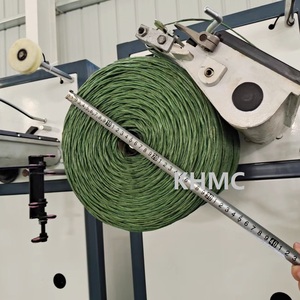
All categories
Featured selections
Trade Assurance
Buyer Central
Help Center
Get the app
Become a supplier

(5096 products available)


















A filament winding machine is used to make filament-wound composite materials through the filament winding method. There are five common types of machines: a direct drive machine, a planetary drive machine, a double rotating machine, a three-dimensional machine, and an isoparametric drive machine.
Direct drive filament winding machine
The direct-drive filament winding machine uses an AC servo motor spindle to directly drive the rotating axis. The motor drives the workpiece to rotate during the winding process without any intermediate transmission mechanism. This can effectively reduce the transmission gap and improve the pre-tension accuracy control of the winding wire. Direct-drive machines offer fast response, high accuracy, and low inertia. They are suitable for winding products that require precise control of pre-tension and winding accuracy. They can meet the winding needs of composite materials with different shapes and specifications.
Planetary drive filament winding machine
The planetary drive filament winding machine uses a planetary gear box as the driving device. The winding axis and its speed are not the same due to the planetary gear's structure and principle of movement. This is another way to achieve the winding replica movement. The planetary gearbox has many advantages, such as a compact design, large transmission ratios, and high efficiency. They can meet the needs of different winding speeds and precision control. So, planetary-drive machines are ideal for making composite material products of various shapes and sizes.
Double rotating filament winding machine
This type of filament winding machine has two rotation systems: the mandrel's rotation and the wire's rotation. This allows for a wide variety of winding methods and winding patterns, which can meet the composite material workpiece with different shape requirements. Meanwhile, the double rotating machine has a high winding speed and efficiency. It can be used for mass production, as well as for large-scale filament winding workpieces, thus meeting the production needs of the filament winding process for different specifications and large quantities of workpieces.
Isoparametric drive machine
The isoparametric drive machine uses a special isoparametric gear transmission to change its speed. It has some advantages, such as a wide transmission ratio range and high reliability. This brings a good flexibility and adaptation to the filament winding process. The isoparametric driver can meet the winding requirements of composite materials with different shapes and sizes by adjusting the winding speed. It can also satisfy the technical needs of different filament winding processes for various kinds of materials and specifications.
Three-dimensional machine
The three-dimensional machine has a CNC control system that can precisely control the moving speed and moving path of the wire now. This allows for winding composite materials with complex shapes and three-dimensional structures. Moreover, the three-dimensional winding machine has a good flexibility and adaptability. It can meet the technical requirement of composite materials with different kinds and specifications. Thus, it can satisfy the winding precision and quality of composite materials with various kinds of materials and specifications.
The filament winding machine performs various applications in different industries. It is mainly used to make composite parts that have a high strength-to-weight ratio. Some industries that use the filament winding machine are the aerospace, sports equipment, automotive, and oil and gas industries.
Choosing a filament winding machine for sale is an easy, straightforward process when one knows the factors to consider. The first step in choosing a suitable filament winding machine is assessing the kind of materials that will be used in the future. The machine that is going to be chosen will usually be compatible with specific composite materials and will have its own set of feed systems, darts, and tension controls.
Another important step in choosing a filament winding machine is determining the available budget for the purchase. Winding machines come in different prices and budgets, so it is essential to look for a vendor or supplier that is within the set budget. Despite what budget one is looking at, it doesn’t hurt to prioritize the quality and reliability of the machine in question.
As winding machines also come in different types, both automatic and semi-automatic, it is important to define the desired level of automation one is comfortable with. Semi-automatic machines require manual setup and loading of the workpiece, while automatic winding machines offer more efficient production, streamlined … and integrated filament feeding and winding control systems.
The size and weight of the filament winding machine to be chosen should be appropriate and should be able to handle the capacity and dimensions of workpieces. The winding area in the chosen machine should also accommodate the maximum diameters of the cylinders.
Finally, the compatibility of the winding machine to be chosen with other production line elements and auxiliary systems, such as the preform transportation systems and fiber feeding systems, should be prioritized. Seamless integration helps enhance productivity.
Q1: Are filament winding machines obsolete in the industry?
A1: No. Filament winding machines are still relevant and widely used in various industries. The machine has been upgraded to suit modern industry demands in aerospace, automotive, sports goods, and many other applications.
Q2: What are some recent trends in filament winding machines?
A2: Some recent trends include automated filament winding machines, flexible production systems, hybrid machines, and integration with CAD/CAM technology.
Q3: What are some challenges faced when using a filament winding machine?
A3: Some challenges include achieving uniform fiber distribution, dealing with complex shapes, maintaining materials compatibility, and the need for skilled operators.
Q4: What are the recent advancements in filament winding technology?
A4: Recent advancements include automated winding patterns, robotic filament winding machines, integration with CAD/CAM technology, and hybrid manufacturing techniques.
Q5: What are the benefits of using a filament winding machine for composite material production?
A5: The filament winding machine offers precise control over fiber orientation, uniform distribution of reinforcing fibers, efficient production of complex shapes, and high-strength lightweight composite materials.